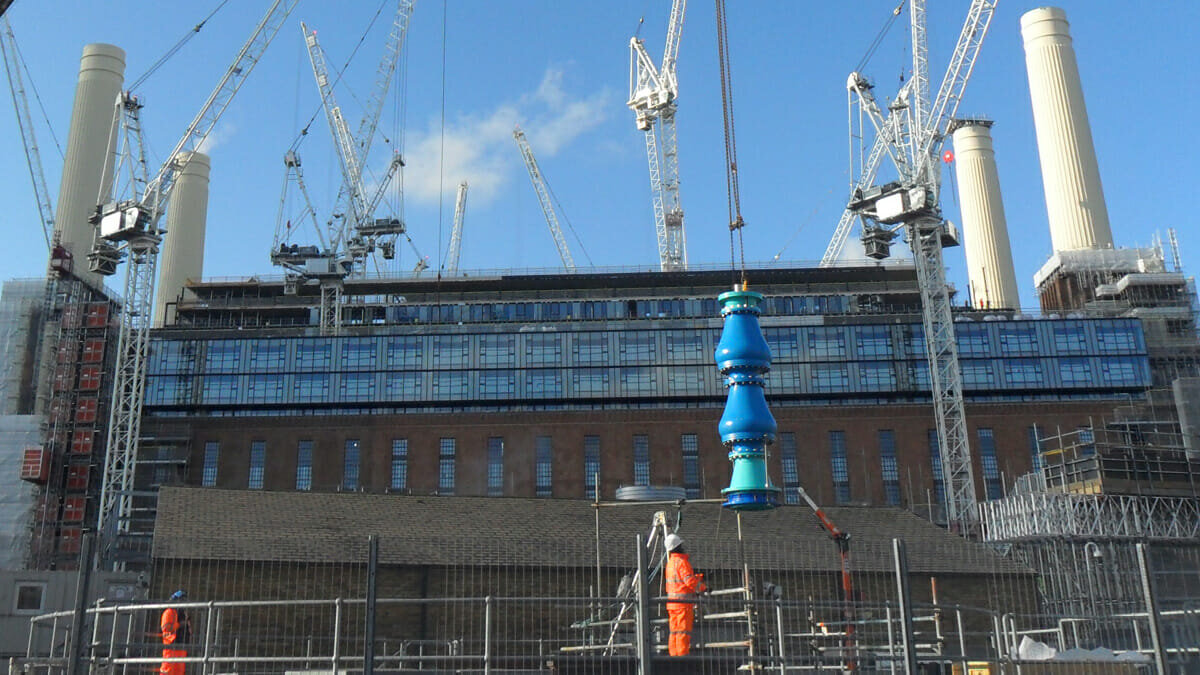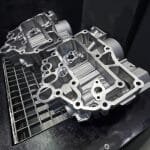~ WEG project replaces critical water pump with minimal disruption ~
Battersea Power Station is a beacon along London’s skyline. Famous for supplying over 20 per cent of all London’s electricity — and as the iconic image on Pink Floyd’s Animals. But, what about Battersea Shaft? Battersea Shaft Pumping Station serves the Thames Water Ring Main, a critical component in London’s water infrastructure. Here, we explain how motor manufacturer, WEG and Bedford Pumps supplied motor technology for this colossal vertical turbine pump.
The Thames Water Ring Main, formerly known as the London Water Ring Main, plays a critical role in supplying drinking water in the capital. Originally built between 1988 and 1993, the structure forms a 50-mile ring of 2.54 metre diameter concrete pipe. Primarily, this is used to transfer drinking water from water treatment plants in the Thames and Lea basins into the city.
The main ring lies between ten and 65 meters below ground level and passes through 21 wells that serve as supply, storage and pumping stations. One of these pumping stations is Battersea Shaft.
Pump infrastructure
Battersea Shaft consists of a large 30-meter-deep vertical shaft, containing six pumps that can supply multiple areas of London with drinkable water. However, increasing development in the city has made it necessary to remodel and replan the network to supply this new demand.
Due to rapidly increasing development in London, predictions suggest that there would be a significant shortage of drinking water capacity in the coming years. To accommodate a growing — and increasingly thirsty population — the station required additional pumping low capacity. This necessitated new equipment in the form of a pump, pump motor and variable speed drive (VSD).
With guidance from a team of experts, it was decided to replace one of the 30 mega-litre per day pumps with a new 45 mega-litre per day option — 45 mega-litre was the maximum limit, due to physical limitations of the environment.

Removing the old pump’s headworks – Courtsey of Stantec
Minimising downtime
However, the real challenge of this replacement was due to the constant demand of drinking water in the capital. To minimise disruption, the pump needed to be replaced without stopping operations. This necessity had a major influence on the design and construction of the pump, and the overall project itself.
It was decided that only the pump that needed to be replaced would be taken offline, enabling the rest of the system to continue operating as normal. However, to achieve this detailed planning of the pumps removal, installation and commissioning was required.
Pump supplier. Bedford Pumps supported this entire process. Through the company’s close relationship with motor manufacturer, WEG, the team were able to replace the pump, without having to resort to cuts in the supply to the London water network.

(left) New pump descending into the shaft (right) new pump being lifted into place – Courtesy of Stantec
Motor specifics
For this application, WEG engineers, along with Bedford Pumps, decided the best option was a water-cooled motor design.
The existing pump and motor had extensive fault detection instrumentation and a monitoring system. Therefore, the same range and functionality was installed in the new pump. In addition, due to the uniqueness of the location, the replacement of any wiring between the electrical equipment and the pump was invasive and required downtime, so all new instrumentation had to be selected to be compatible with the existing wiring. Further complicating the motor selection process.
Thankfully, WEG is an expert in delivering motors for unique pumping applications. For this application, WEG chose a 450 kW Master Line Water Cooled induction motor. These motors stand out for the flexibility of their electrical and mechanical functionalities. What’s more, these designs are easily customised, making them interchangeable with already existing motors.
For the Battersea Shaft Pumping Station, WEG committed to achieve 96 per cent efficiency performance. Following completion of the project, during testing this figure was not only achieved but exceeded with a greater margin.
Following completion in January 2020, the pump is now fully commissioned and in full service. What’s notable, is that designing the new equipment to work with existing infrastructure, together with detailed construction planning, massively minimised the installation period for the project. And crucially, avoided pumping station outages.
The Battersea Shaft Pumping Station is another of WEG’s successful projects for the water sector. WEG motors are also fitted on the largest river water extraction pumping station in the United Kingdom, as well as the largest pumping station in Ireland.
More information on WEG’s offering for the water sector can be found at www.weg.net.








